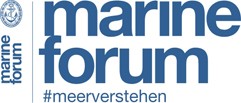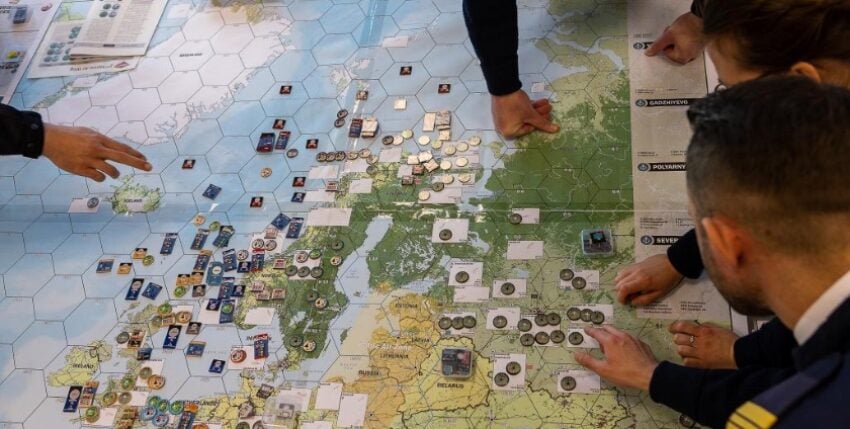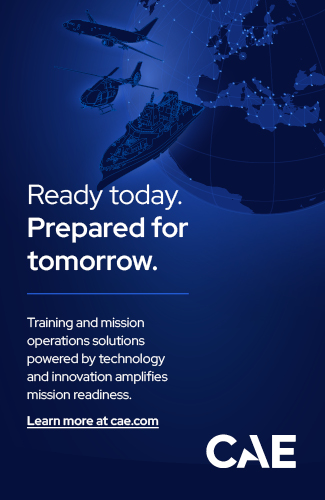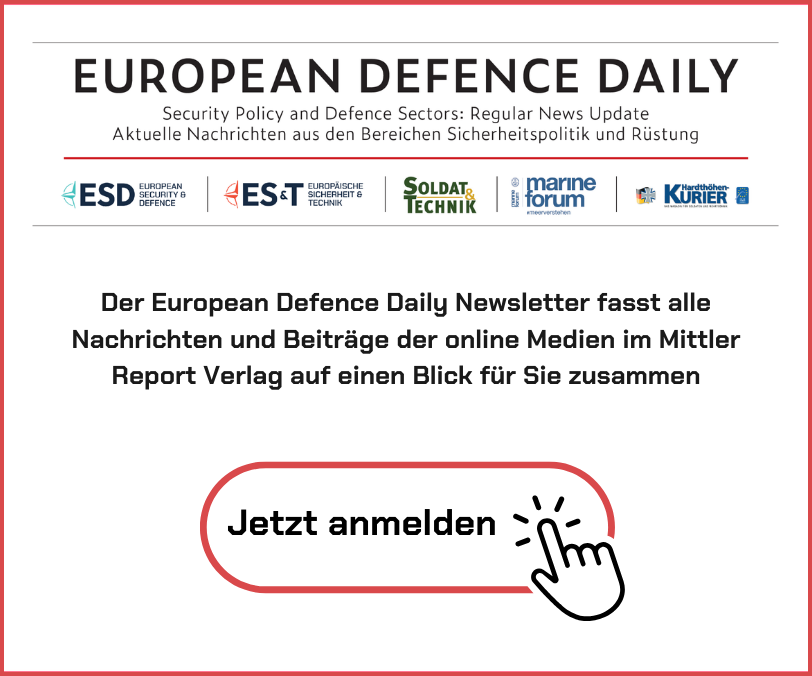With the return to national and alliance defence, it is not only the main area of operation that is changing for the German Navy. It is also necessary to adapt operational officer training.
NATO's strategic concept adopted at the Lisbon Summit in 2010 stated that "peace reigns in the Euro-Atlantic area". Relations with Russia were characterised by dialogue and the Bundeswehr's attention was primarily focused on the Afghanistan mission. Overall, the armed forces were primarily in demand worldwide in their role as crisis managers. For the navy, the capability for three-dimensional naval warfare therefore took a back seat to international crisis management (ICM) missions. Accordingly, the focus was also on Exercises and training for maritime surveillance missions, support for embargoes or anti-piracy operations.
Since then, the security situation has changed massively. Alliance defence and deterrence (SACEUR's Deterrence and Defence Initiative in 2020) has been gradually stepped up and the German Navy has increasingly focused on three-dimensional naval warfare in the sense of downward compatibility - "Those who can wage war can also hunt pirates".
However, the Russian war of aggression against Ukraine from 24 February 2022 at the latest represents a turning point in security policy. With the new strategic concept adopted at the Madrid summit in June 2022, NATO is once again focusing on alliance defence and deterrence. This is also reflected in the German government's national security strategy "Wehrhaft. Resilient. Sustainable. Integrated Security for Germany". National and Alliance defence, including the contribution to the Alliance's deterrence capability, is named as the core mission of the Bundeswehr. All other tasks must be subordinate to this.
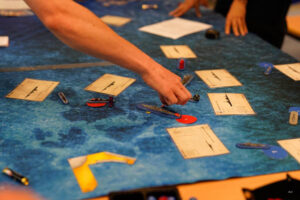
In April 2022, the Commander's Intent of the Chief of Naval Operations defined the Navy's consistent focus on national and alliance defence and the northern flank with the adjoining important sea lanes across the Atlantic as the main area of operation. Equipment, training, command and control and participation in exercises must be adapted to this.
This shift in focus from ICM to LV/BV was clearly reflected this September in the major international exercise "Northern Coasts 23" in the Baltic Sea, which was planned and conducted by Germany and involved around 3,200 soldiers from 14 countries. The exercise did not go unnoticed by the population. Aircraft such as the US Marine Corps' V-22 Osprey vertical take-off and landing aircraft equipped with tilt rotors are not seen every day on the Baltic coast. Northern Coasts 23" focussed on three-dimensional naval warfare and the impact of the sea on land.
For the officers of the German Navy deployed in the Operations Service, this means that they must be able to safely control their own weapon system in combat in LV/BV scenarios and think, plan and act across dimensions and multinationally. High-quality and realistic training is required to prepare them for this task. This takes place as part of a training programme at the Naval Operations School in Bremerhaven, traditionally known in the German Navy as the B course. As part of this training, the female officers are qualified for the challenges of combat, prominent leadership positions on board and the planning of operations following their first officer assignment.
The core of the B-course training was and is the comprehensive teaching of the various facets of naval warfare. However, over the years, different priorities have been set depending on the likely mission profile. For a long time, training focussed on topics and areas of operation relevant to ICM missions. At the same time, weapon-specific components were strengthened and joint operational components were reduced in order to make personnel available on board quickly. Three of the former twelve joint months remained. However, this no longer meets the training requirements for the relevant personnel due to the current threat reality in the Baltic Sea region and on the northern flank of the alliance area.
For this reason, the Commander of the Fleet and Support Forces has instructed the Training Division of the Naval Command to review operational training together with the task forces and the Naval Operations School and make any necessary adjustments. The aim is to enable our officers to succeed and win in combat. In today's highly networked operational environment, a greater common tactical and operational understanding is essential for this.
To this end, the training components that lay the common tactical foundation will be extended from three to four months in future, as the necessary foundations have become more extensive due to the further development of the individual types of naval warfare. In order to maximise the knowledge of the correct approach of one's own unit in a joint operation in the two-month tactical phase that builds on this, a weapon-specific component will also be inserted in between.
The basic section forms the basis for imparting knowledge about types of naval warfare and operational functions with which officers have previously had little to do. This includes logistics, leadership skills, underwater and surface warfare, naval warfare from the air and from sea to land. In terms of competence-orientated training (KOA), this means that a female submariner, for example, is available as an expert for relevant instruction during this phase, while at the same time benefiting from the knowledge of her comrades.
The aim of the training, which is differentiated according to the different units and their specific requirements, is to provide officers with in-depth training in the special features of their own weapon system and to familiarise them with the latest tactical developments.
This ensures that they have acquired the knowledge required to participate in the subsequent tactical phase and thus contribute to its success. In this training phase, the content taught, the participants' experiences and new approaches in defence technology research are combined with the latest findings from military intelligence on the capabilities of the enemy. This provides the officers with a solid tactical assessment basis to enable them to make well-founded decisions in planning exercises and wargaming. The instruction at the Naval Operations School is supplemented by lectures at external organisations. For example, the Submarine Training Centre, the Mine Training Centre, the Naval Battalion, the Naval Special Forces Command, the Naval Hydroacoustic Analysis Centre, the Operational Testing Centre and defence technology departments are integrated as fixed components of this training section.
In order to focus not only on LV/BV in the theoretical training, all practical exercises in the simulator, the wargaming and the operational planning process are also focussed on the main operational areas of the German Navy, the Baltic Sea and the northern flank. Realistic scenarios are practised in the context of LV/BV.
As already mentioned, the wargaming method is to be increasingly utilised in naval training - as in the German armed forces as a whole. The Bundeswehr Command and Staff College and the Air Force Officer Training School have been pioneers in this area to date.
The use of wargaming methods is intended to improve the ability of management personnel to make successful decisions. By simplifying and visualising complex relationships, coupled with game elements, wargaming can complement many learning and teaching situations in a meaningful and sustainable way. Wargaming also fits in perfectly with the ongoing transition of training to KOA; it awakens the need to learn and strengthens individual competences.
After completing the tactical phase, the training participants leave the Naval Operations School for their future units and formations. For "female frigate and corvette operators", this is followed by a further 4-month specialisation module, meaning that their entire training will take 13 months in future. Here, the focus is on practical exercises to further deepen the three-dimensional naval warfare. The module concludes with type-specific system training - depending on the future weapon system. In this way, the learning of operational principles and procedures is combined with the teaching of the absolutely necessary system and system knowledge in a targeted manner.
With the adaptation of the B course, the "operational officers" of the Navy will in future be comprehensively enabled to safely control their own weapon system in three-dimensional naval warfare and, with extensive knowledge of tactical-operational contexts, their own as well as naval warfare means of allied forces and potential opponents, to achieve the necessary effects in combat and to advise their superiors on the deployment and deployment of forces in a targeted manner.
Frigate Captain Dr rer.nat. Connie Walther is a member of the OP MilGeo department at Rostock Naval Command.
Christian Moritz and Daniel Wolter
